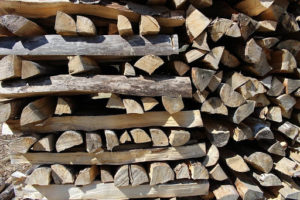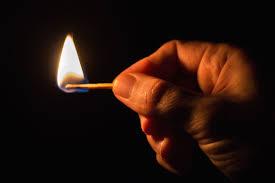Old-timers will tell you the best firewood comes from most any tree that has been cut into logs and well dried or “seasoned” before use, then stacked under covered storage. You really can burn most any tree wood so long as it’s been cured under cover and if you learn to recognize the properties of various wood types so you can burn them most appropriately.
You may have heard the term “green” firewood. Just like firewood that’s been rained on, “green” refers to freshly cut wood. Both green wood and wood that’s exposed to the elements contain excessive moisture, and what happens when this green/wet wood is burned is a primary cause of chimney fires.
A tree has small tubes in it that deliver water from the roots to the trunk and branches. Months after the wood has been cut, there is still water in these tubes. “Seasoning” refers to storing the wood properly to help dry out this moisture.
| 3 STAGES OF CREOSOTE
First Degree: Lighter soot that can be brushed out of the chimney. A sign of using good quality firewood and good burning habits Second Degree: Shiny flakes of hard tar; still fairly removable with chimney brushes is most cases. Commonly found with chimneys venting a wood stove, or a fireplace that’s been burned with the glass doors closed Third Degree: A consistency much like sticky tar on a road, evolving to a hard, thick and shiny consistency like peanut brittle. Cannot be cleaned with chimney brushes. Commonly found where one or more of these burning conditions: (1) Burning unseasoned or wet wood (2) Burning wood stoves with a very slow fire (3) Uninsulated chimneys or chimneys built on an exterior wall of the home (4) Chimney is too large for the fireplace or wood stove that it’s venting (5) A tightly constructed home that provides insufficient air to burn the wood efficiently |
When wood burns, not all of the chemicals produced are actually burned. Chemicals in the wood combine with moisture and create smoke. When smoke cools down and becomes solid, it leaves a solid residue in your chimney known as CREOSOTE. Creosote is defined in STAGES (see side panel for further description.) Removal of soot and creosote is the objective of sweeping a chimney.
Before wood can actually begin to burn, the water must be boiled off during the combustion process. This water rises up the chimney along with the excessive smoke it produces, creating a nasty tar-like buildup in your chimney. Over time this sticky tar dries out and becomes hard; similar to the consistency of peanut brittle, it’s very difficult to clean out of the chimney without using either harsh chemicals or specially made mechanical devices. This type of buildup is known as “Stage 3” creosote; besides being devilishly difficult for us to remove from your chimney it also tends to cause the most devastating type of chimney fire when this type of residue catches fire inside your chimney.
Prepare in spring and summer for next year’s wood burning
As soon as you stop burning your wood stove or fireplace, please call us to come inspect your chimney and clean it if it’s needed.
Cut or purchase your firewood right away. A tree cut down before February, when the sap begins to flow, is the best choice. Cutting it into logs right away helps the firewood season – or dry out – much faster.
When purchasing firewood, look for wood that’s gray or dark colored and that has small cracks in the ends, a sign that it is seasoned. Wood with bark falling off is the most seasoned because bark requires moisture in order to adhere to the wood. You’ll usually get a price break if you buy your firewood in the off-season.
| A CORD OF WOOD is a pile 8’ x 4’ x 4’. A “Face Cord” or a “Rick” is roughly half that; it’s a pile 8’ x 4’ x the length of a log |
Cover the top of your wood pile so it can’t get rained on, but leave the sides open to promote air drying. Stack your firewood so it’s not touching the ground, which helps prevent your firewood from absorbing rainwater. Wood pallets will last a couple of seasons for this purpose. Your woodpile should be loosely stacked to help air flow.
What Type of Wood Should I Burn?
Trees are defined as Softwoods or Hardwoods. Softwoods are good for a quick, hot fire and are ideal for getting a fire lit because they ignite quickly. Hardwoods are denser so they burn longer and slower, and are a good choice for a longer, slower fire. Ideally, once the fire is established, try to burn only hardwoods in your wood stove.
Soft Woods Include
- Pine
- Douglas Fir
- White Spruce
- Cedar
Hardwoods Include
- Oak (White Oak or Red Oak)
- Ash
- Birch
- Beech
- Hard Maple
- Hickory
- Pecan
- Dogwood
- Almond
- Apple
What Not to Burn
Of course, you should only burn natural firewood in your fire pit, fireplace or wood stove. However, the items below deserve a special mention as far as what to avoid.
- Salt treated or chemically treated wood
- Wood with paint or varnish on it
- Plywood or particle board
- Christmas Trees
- Cardboard, especially pizza boxes!
- Waxy paper or paper with colored print
- Driftwood
